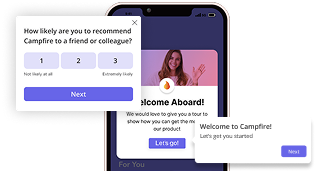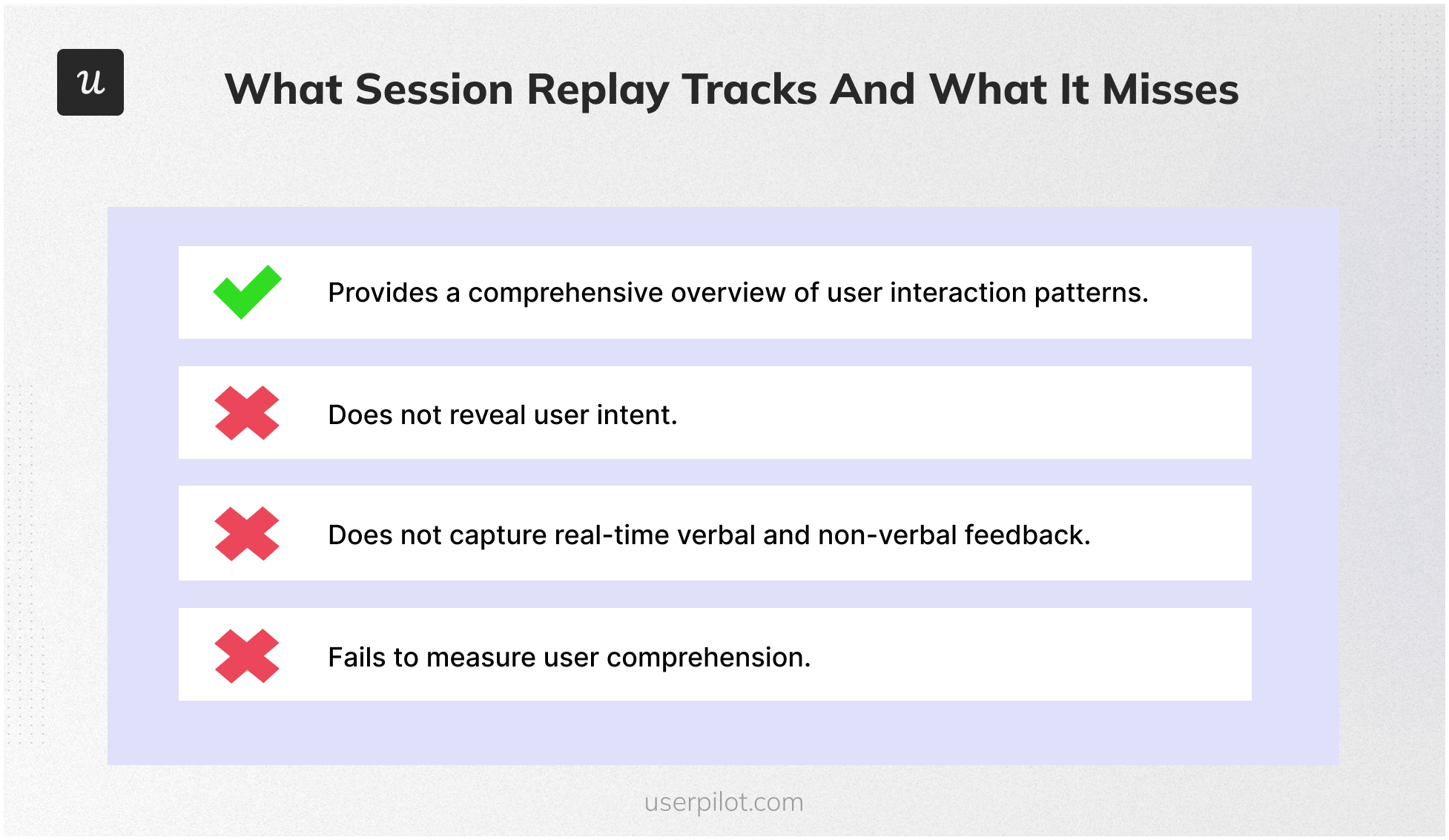Session Replay vs. Usability Testing: Uncovering the Why Behind User Behavior
Anna, a lead product manager at a B2B SaaS company, is responsible for improving the onboarding flow of a financial dashboard. Her goal? Reduce friction and improve user activation.
A week after launching an updated step-by-step onboarding guide, she checks session replays to see how users engage with the new experience.
The numbers tell an interesting story:
- 40% of users drop off at Step 3 (where users select their financial preferences).
- Users repeatedly hover over the “Risk Selection” section but don’t click.
- Many rage-click “Next” before abandoning the process altogether.
Anna has found out what is happening, but she still doesn’t know why it’s happening.
💡 Session replay tells her that users hesitate at Step 3, but not whether they are confused, frustrated, or distrustful of the interface.
To bridge this gap, she runs a usability test with 8 participants, using a controlled setup where she can track both verbal and non-verbal reactions while collecting quantitative metrics such as:
- Task success rate: Only 50% of users completed onboarding.
- Time on task: Users spent an average of 2 minutes struggling at Step 3.
- Error rate: 25% of users selected the wrong risk levels but didn’t notice.
- Satisfaction score: The onboarding experience was rated 58, far below the acceptable usability benchmark of 70+).
By observing participants in a controlled setting, Anna discovers the real issue:
- Users don’t understand how risk selection affects their financial profile—the interface lacks clarity.
- The UI doesn’t confirm their selection, leaving users uncertain if they’ve made the right choice.
- Verbal feedback confirms hesitation—participants explicitly mention the fear of making an irreversible mistake.
🔑 Key insight: Session replay shows friction patterns at scale. Usability testing isolates why they occur—by capturing user reasoning, decision-making strategies, and confidence levels in a controlled setting.
Try Userpilot Now
See Why 1,000+ Teams Choose Userpilot

What session replay captures (and what it doesn’t)

Session replay tools provide a high-level behavioral overview of user interactions by capturing:
- Clickstreams and mouse movements → where users click, hover, and scroll.
- Rage clicks and dead clicks → Frustration signals when users repeatedly click unresponsive elements.
- Time on task and drop-offs → Tracks where users hesitate or abandon a process.
📌 Example: In the financial dashboard onboarding scenario above, session replay detects that users hover over a tooltip icon without clicking—but it doesn’t explain why.
Where session replay falls short
- Cannot capture user intent → It shows hesitation, but not whether users are confused, distrustful, or distracted.
- Lacks real-time verbal and non-verbal feedback → You don’t know if users are thinking “I don’t trust this” or just pausing momentarily.
- Does not measure comprehension → Users may progress through a form without truly understanding the choices they’ve made.
The advantage of usability testing: Tracking the why in a controlled environment
Unlike session replay, usability testing is not just about observation—it allows researchers to:
- Control the testing environment to isolate variables affecting user behavior.
- Track verbal and non-verbal behaviors (e.g., eye movements, pauses, hesitations, body language).
- Measure both qualitative and quantitative usability performance, which I’ll cover in detail below.
Learn More from the Interview with Alessio Romito.

Quantitative usability metrics
- Task completion rate → Percentage of users who successfully complete an action.
- Time on task → Tracks efficiency, but also hesitation patterns.
- Error rate → Indicates incorrect actions or failed attempts.
- Satisfaction scores (SUS, SEQ, UMUX-LITE) → Measures ease of use, confidence, and frustration.
- Problem occurrence rate → Tracks how frequently usability issues arise.
Qualitative usability metrics
- Hesitation and pauses → Measures uncertainty and cognitive load (e.g., long pauses before an action).
- Facial expressions and body language → Indicates frustration, confusion, or confidence.
- Think-aloud protocol feedback → Captures real-time verbalized thoughts while completing a task.
- Expectation mismatch → Detects when user expectations don’t align with system behavior (e.g., “I thought clicking this would take me to X, but it didn’t”).
- Confidence and trust signals → Captured through post-task reflections, assessing how sure a user was about their action.
📌 Example: Coming back to the original example, session replay showed that users dropped off at Step 3, while usability testing revealed:
- Long pauses before risk selection (hesitation).
- Confused facial expressions as users scrolled back up.
- Users verbalized uncertainty—saying things like “I don’t know if I’m making the right choice here.”
To fix these issues, Anna added a clear explanation under each risk level and a final confirmation message, instead of just tweaking UI colors. The impact? Completion rates increased by 20%, and satisfaction scores rose from 58 to 74.
Session replay vs. usability testing: A complete comparison
| Metric Type | Session Replay | Usability Testing |
| Tracking behavioral trends at scale | ✅ Best for analyzing thousands of sessions | ❌ Not scalable |
| Measuring completion rates, error rates, and time on task | ✅ Tracks passive metrics | ✅ Captures metrics in a controlled setting |
| Identifying rage clicks, dead clicks, scrolling friction | ✅ Detects frustration signals | ❌ Not primary focus |
| Understanding why users hesitate | ❌ Cannot determine intent | ✅ Captures hesitation and cognitive load |
| Measuring confidence, trust, and expectations | ❌ Cannot assess trust issues | ✅ Captures decision-making cues |
| Tracking facial expressions and body language | ❌ Not possible | ✅ Observed in controlled settings |
| Evaluating comprehension and learning barriers | ❌ Cannot assess user understanding | ✅ Think-aloud protocol and expectation mismatch |
| Testing new designs before launch | ❌ Limited to live UI | ✅ Controlled pre-launch usability tests |
💡 Key takeaways
- Session replay is great for detecting macro-level friction.
- Usability testing is essential for diagnosing behavioral and cognitive barriers.
How to integrate both methods for maximum UX impact?
- Step 1: Use session replay to identify behavior trends → Look for high-drop off points, repeated clicks, and hesitation patterns.
- Step 2: Conduct usability testing to isolate user intent → Test problematic areas with task-based usability testing and capture verbal and non-verbal feedback.
- Step 3: Implement changes and track post-fix behavior with session replay → Measure improvement in completion rates, hesitation time, and error reduction.
Conclusion: The power of combining behavioral analytics and controlled research
Here are some key lessons you should take away from this article:
- Session replay tracks usability at scale but lacks cognitive insights.
- Usability testing isolates reasoning and decision-making behaviors.
- Verbal and non-verbal cues add essential context to user frustration.
- Combining both methods ensures a complete UX research approach.
👉🏻 Final thought: Quantitative data shows friction. Controlled research reveals intent. The best UX strategies leverage both.
Don’t Miss Out on Expert Knowledge That Keeps You Ahead.


